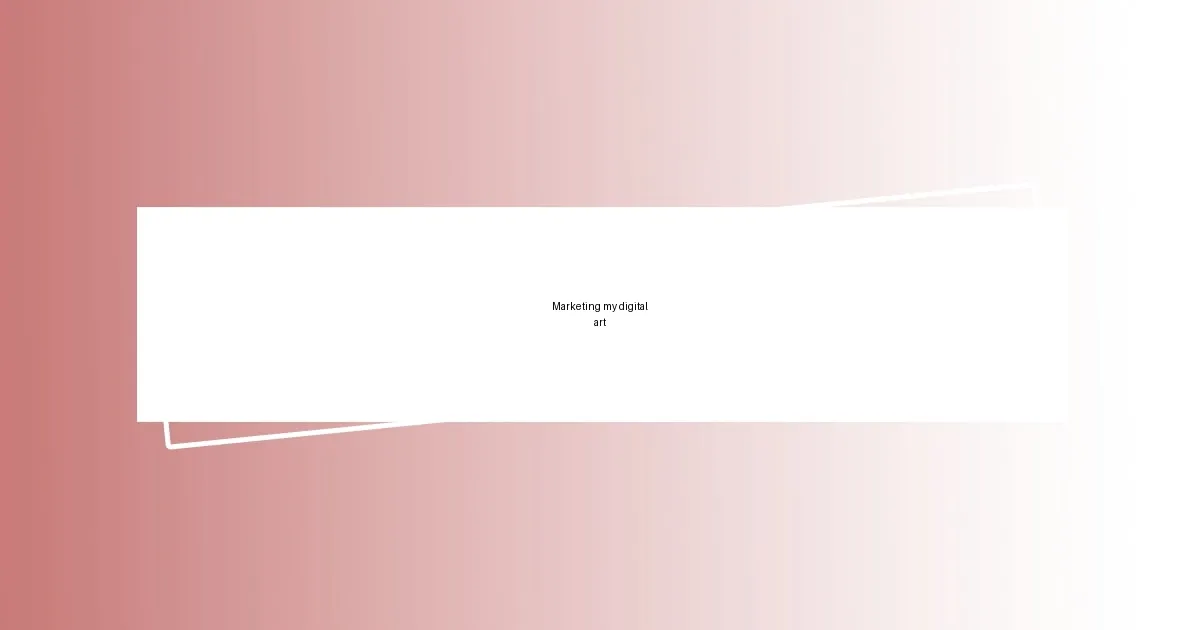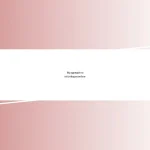Key takeaways:
- Transitioning to digital illustration reignited the author’s creativity, highlighting the importance of experimenting with new tools and techniques.
- Finding the right tools like Procreate profoundly impacted the author’s artistic style and workflow efficiency.
- Building an online portfolio helped the author articulate their artistic journey and connect with the audience through curated storytelling.
- Networking with fellow artists fostered a supportive community, enhancing the author’s skills and inspiring further artistic growth.

My journey to digital illustration
Transitioning to digital illustration was like stepping into a vibrant new world for me. I still remember the first time I opened a drawing app; my heart raced with excitement and a hint of anxiety. Could I actually recreate the depth and texture of my traditional work on a screen?
I vividly recall the night I clicked “save” on my very first digital piece. I held my breath, nerves tingling; it felt surreal. There was this moment of pure joy when I realized I could undo mistakes with a simple click instead of scrambling for an eraser. It made me think – how often do we let the fear of making mistakes hold us back from exploring new possibilities?
Over time, I found myself falling in love with the versatility of digital tools. The endless color palettes and layering options unlocked a creative freedom that traditional mediums sometimes constrained. This shift wasn’t just about the tools; it was about rediscovering my artistic voice and, in a way, rewriting my journey as an artist.

Discovering my art style
Discovering my art style in the digital realm was a journey of exploration and self-discovery. One late afternoon, I was experimenting with various brushes and stumbled across a watercolor effect that took my breath away. The vibrant hues flowing across the canvas felt so much like my beloved watercolors, yet they provided a new dynamic that made my heart skip a beat. It was in that moment that I realized my style didn’t have to be confined to traditional mediums; it had the potential to evolve and adapt.
As I navigated through different digital techniques, I began to recognize what truly resonated with me. Here’s what I learned along the way:
- Experimentation is key: Mixing styles, like combining elements of surrealism with realism, sparked my creativity.
- Reflection on past works: Analyzing my traditional pieces helped highlight which aspects of my style I wanted to bring into digital illustration.
- Finding my color palette: I discovered a unique selection of colors that felt like ‘me’ and influenced my signature look.
- Taking breaks for inspiration: Walking away from the screen to sketch ideas on paper often led to the best digital outcomes.
- Community input: Sharing my work in online forums helped me gather feedback that nudged me toward refining my style.

Choosing the right tools
Choosing the right tools was crucial for me as I embarked on my digital illustration journey. Initially, I felt overwhelmed by the sheer number of options available. However, after several late-night sessions experimenting with different software and hardware, I realized that the tools I chose ended up influencing my style profoundly. For instance, I started with a basic tablet and a free app. While they were functional, I eventually upgraded to a more sensitive tablet and software with versatile brush options. This change significantly enhanced my dexterity and creativity.
One tool that made a lasting impression was Procreate. I remember the first time I laid my stylus on my iPad; it felt as if the canvas was a part of me. The intuitive layout allowed me to focus on my art rather than struggle with the software. It motivated me to push my boundaries further than I thought possible. Similarly, the plethora of brushes available sparked an idea – why not create custom brushes that mimic my favorite traditional mediums? It was delightful to blend the digital and traditional, resulting in a signature touch that was entirely my own.
Having recognized how pivotal the right tools are, I also realized it’s essential to prioritize comfort and functionality over a brand name or price tag. The experience of finding what works for you is uniquely gratifying and can even spark unexpected creativity. In this table, I’ve summarized some of the main tools that influenced my path, weighing their pros and cons to assist others on a similar journey.
| Tool | Pros |
|---|---|
| Graphics Tablet | Enhanced precision; offers a natural drawing experience |
| Procreate | User-friendly interface; extensive brush library and customization |
| Adobe Illustrator | Powerful vector capabilities; great for scalable designs |
| Krita | Free software with good brush dynamics; perfect for beginners |
| Clip Studio Paint | Ideal for comic artists; great for lineart and coloring |

Learning digital techniques
Learning digital techniques was an adventure that constantly surprised me. I vividly remember the first time I tried layering in a digital painting—each layer felt like a new dimension opening up. It baffled me at first; how could a simple toggle and a few clicks result in such depth? That moment was a game changer for me, as I quickly learned that mastering layers could completely transform my workflow.
As I delved deeper, I discovered shortcuts that became game-changers. Have you ever felt like time slipped away while you were lost in your artwork? I certainly did, especially when I stumbled upon the power of keyboard shortcuts. Suddenly, the process was faster, and my creativity flourished. It’s almost like having a secret superpower that allowed me to be more efficient and focus on the fun parts of creating. I found great joy in mastering these digital techniques, and it made me feel empowered to experiment further.
Furthermore, I often engaged with online tutorials, which were like little gold mines of knowledge. One tutorial on blending modes took my colors to a whole new level—have you ever witnessed a color shift that just made everything click? For me, it was like discovering a lost piece of my artistic puzzle. Not only did these techniques enrich my illustrations, but they also reignited my passion for creating art in a way that felt new and exhilarating. Each tutorial was a step on a journey that encouraged me to push my boundaries and explore my artistic potential freely.

Building an online portfolio
Creating an online portfolio was one of the most exciting yet nerve-wracking experiences for me. I still remember the mix of anticipation and doubt as I uploaded my first digital pieces. Would they resonate with anyone? I quickly learned that showcasing your work is about telling a story. Each piece reflects not just your skill but also your journey, your growth, and the lessons you’ve learned along the way.
As I built my portfolio, I realized that simplicity often speaks volumes. Instead of cluttering my site with every piece I had ever created, I chose to highlight a curated selection. Focusing on the pieces that truly represented my style made a significant difference. Have you ever walked into a gallery and felt overwhelmed by too much to see? I wanted to avoid that feeling on my portfolio. Each piece was selected to evoke a specific emotion or concept, drawing viewers into my artistic narrative.
Moreover, I discovered the importance of updating my portfolio regularly. It’s not just a one-time task; it’s an ongoing process. With every new technique I learned or style I experimented with, I felt compelled to refresh my portfolio. I remember the exhilaration of adding a new piece that represented a breakthrough moment in my development. It’s like sharing a piece of my soul with the world. I realized that my online portfolio isn’t just a collection of work—it’s a living document that evolves alongside me as an artist.

Networking with other artists
Establishing connections with other artists has been one of the most rewarding aspects of my journey into digital illustration. I remember my first online art group meeting vividly; I was both nervous and excited. The moment I shared my work and received feedback felt like a mix of vulnerability and exhilaration. You know that feeling when someone truly gets your art? It was a reminder that we’re all navigating similar paths, and I realized how invaluable support and camaraderie can be.
In the age of social media, I found that engaging with fellow artists was easier than ever. I often joined discussions in forums or groups, sharing insights and seeking advice. Have you ever posted a question and found an outpouring of support? I surely have, and it was an eye-opener. Collaborating on projects or simply discussing techniques has not only expanded my skillset but has also paved the way for friendships that I cherish. It feels incredible to celebrate each other’s milestones, whether it’s a completed piece or reaching a new follower count.
Networking doesn’t have to be formal, either. Attending local art fairs and events turned into wonderful opportunities for me to meet artists face-to-face. I clearly remember striking up a conversation with a digital illustrator whose work I admired. We bonded over our favorite apps and shared tips, and that moment sparked ongoing communication between us. It’s these personal connections, whether online or in-person, that enrich your experience as an artist, providing inspiration and fresh perspectives that keep us all motivated and growing.

Marketing my digital art
Marketing my digital art has been an insightful journey that challenged me to think outside the box. At first, I relied heavily on social media platforms like Instagram and Pinterest to showcase my work, crafting each post as if it were a mini-exhibition. I remember the thrill of gaining my first 100 followers—it felt like a validation of my efforts, and I often wondered what drew people to my art. Was it the colors, the themes, or maybe the stories behind the pieces?
As I delved deeper into the marketing aspect, I realized that storytelling plays an essential role in connecting with my audience. I began to share not just the finished pieces, but also behind-the-scenes glimpses of my creative process. I vividly recall the day I posted a timelapse of my digital illustration in progress; the engagement was overwhelming! It sparked questions and comments from followers, leading to discussions that felt more like a gathering of friends. Hasn’t that sense of community made you feel more invested in an artist’s work?
Email newsletters became a game-changer for me. By inviting my followers to subscribe, I created a direct line of communication, allowing me to share exclusive content and special offers. The first time I sent out a newsletter featuring a limited-edition print, I felt a rush of excitement mixed with uncertainty. Would anyone respond? The satisfaction of seeing those sales come in made all the effort worthwhile. Through email, I not only marketed my art but also forged a deeper connection with my audience, providing them with a more personal experience of my creativity.














